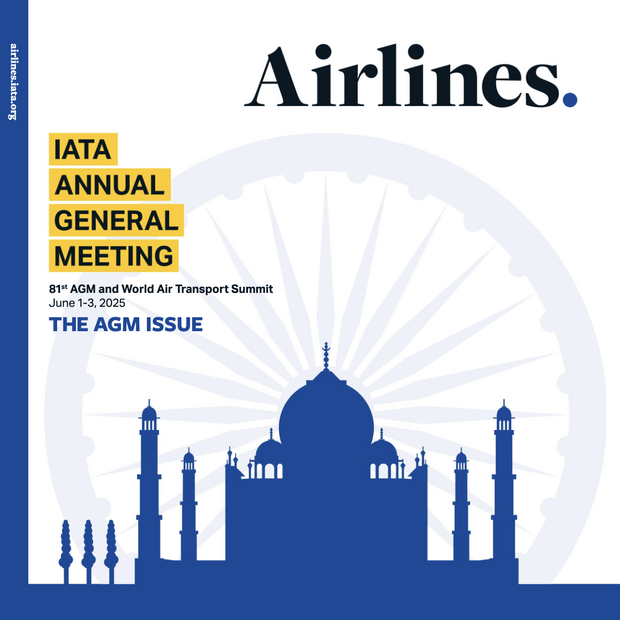
Geneva – The International Air Transport Association (IATA) has released the latest edition of the World Air Transport Statistics (WATS) with comprehensive statistical data for 2024.
Updated annually with data from over 240 international airlines, the WATS database provides a complete overview of airline metrics related to demand, supply, and performance. The report includes a detailed breakdown of scheduled passenger and cargo traffic demand, scheduled passenger and cargo capacity, overview of the global airline fleet, and top airport pairs.
The report also provides details on the financial health of the industry with in-depth information on operating costs and revenue, aircraft utilization and number of airline employees.
Premium Classes Show Strong Growth
A key finding from this year’s report showed that international premium class travel—business and first class—grew by 11.8%, outpacing growth in global economy travel of 11.5%. The total number of international premium-class travelers in 2024 was 116.9 million (6% of total international passengers).
Leading the regions in terms of percentage growth was Asia Pacific with a year-on-year growth of 22.8% with 21 million premium passengers—although it was outpaced in growth by economy class passenger numbers, up 28.6% to 500.8 million. Growth in premium travel exceeded economy class travel in Europe, Latin America, Middle East and North America. Europe remained the largest market for international premium travel, with 39.3 million premium passengers while premium travelers as a percentage of all travelers were highest in the Middle East at 14.7%.
Top Airport Pairs
Asia Pacific dominated the ranking for the world’s busiest airport pairs, with Jeju-Seoul (CJU-GMP) the most popular route globally, with13.2 million passengers flying between the two airports in 2024. In the top 10, only one airport pair—Jeddah-Riyadh (JED-RUH) —was not in the Asia Pacific region.
Bogota-Medellin (BOG-MDE) was the busiest route in Latin America with 3.8 million passengers while Cape Town-Johannesburg (CPT-JNB) was Africa’s busiest route, with 3.3 million passengers. New York John F. Kennedy International Airport-Los Angeles (JFK-LAX) was the busiest route in North America with 2.2 million passengers while Barcelona-Palma de Mallorca (BCN-PMI) was the busiest within Europe with 2 million passengers.
Most Used Aircraft
Narrowbody aircraft from Boeing and Airbus were among the most used aircraft in 2024. Boeing 737 aircraft (including all variants) flew 10 million flights with 2.4 trillion Available Seat Kilometers (ASKs) in 2024. This was followed by the Airbus A320 with 7.9 million flights and 1.7 trillion ASKs and the Airbus A321 with 3.4 million flights and 1.1 trillion ASKs.
Most Used Aircraft Globally:
| Aircraft type / Model | Frequency | Frequency YoY | ASK | ASK YOY |
|---|---|---|---|---|
| Narrow Body / Boeing 737 (all variants) | 10m | 6% | 2,442b | 9.5% |
| Narrow Body / Airbus A320 | 7.9m | 4.8% | 1,705.7b | 6% |
| Narrow Body / Airbus A321 | 3.4m | 10.1% | 1,124.1b | 12.5% |
| Narrow Body / Airbus A319 | 1.4m | -6% | 204.2b | -4.9% |
| Narrow Body / Airbus A220 | 411,543 | 21.7% | 66.6b | 20.4% |
Top Passenger Countries
The US remains the world’s biggest aviation market* with 876 million passengers in 2024 on the strength of its domestic market, growing 5.2% year-on-year. China was the second-biggest passenger market, with 741 million passengers, a growth of 18.7% compared to 2023.
Biggest Passenger Markets in 2024:
| Country | Passenger | Change % |
|---|---|---|
| United States | 876m | 5.2% |
| China (People's Republic of) | 741m | 18.7% |
| United Kingdom | 261m | 7.3% |
| Spain | 241m | 10.7% |
| India | 211m | 11.1% |
| Japan | 205m | 18.6% |
*These figures include all passengers (international and domestic) departing or arriving in each country.
> Learn more about the WATS report
For more information, please contact:
Corporate Communications
Tel: +41 22 770 2967
Email: corpcomms@iata.org
Notes for Editors:
- IATA (International Air Transport Association) represents some 360 airlines comprising over 80% of global air traffic.
- You can follow us on X for announcements, policy positions, and other useful industry information.
- Fly Net Zero

